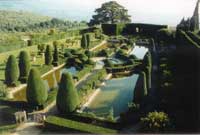| |
|
San Quirico d'Orcia
is a charming, walled town on the northern edge of the Val d'Orcia. San Quirico d'Orcia is Etruscan in origin, and cinerary urns and other funeral objects and vessels found here are now kept in the Etruscan archeological museum in Sienna.
The Collegial Church of Saints Quirico and Giuditta is built in the Romanesque style. It has three portals; the south one is attributed to Giovanni Pisanu. Inside there is an altarpiece by Sano di Pietro and a choir that dates from 1432-1502.
From the beginning of the 11th century, the name of San Quirico in Osenna is mentioned more frequently, especially in connection to travel along the important Via Francigena.
A large part of the antique town walls (La cinta muraria di San Quirico) still stand along with 14 small towers, although some of them are incorporated into other buildings. Unfortunately, nothing remains of the North and South gates, although the partially original Eastern gate is preserved. Probably this was originally preceded by an outer gate, of which only the base remains.
The Collegiata dei Santi Quirico e Giulitta was built on the site of the old parish church, which dated from the 8th century. The actual structure dates back to the 12th-13th centuries. La Collegiata has three portals. The first, brought from Siena, is a magnificent example of Romanesque art, constructed of sandstone and travertine. An extraordinary wealth of symbolic religious themes can be seen on the inside of the great round arch. The first portale di mezzogiorno (southern door) is attributed to Giovanni Pisano. With its protruding porch supported on two columns, and with its wonderful balance, it encorporates elements of the Classical, Romanesque and Gothic styles. The bell-tower, as it appears today, was built at the end of the 18TH century and replaced the old, arched bell tower. Inside the church, there is a triangular beamed ceiling. The baroque choir was built in 1655, replacing the original apse, and the high altar is in the rococo style. Behind the altar, the magnificent, inlaid panels, by the Siennese Antonio Barili, date from between 1482 and 1502. The nineteen wonderful marquetry panels, of which only seven are still at San Quirico, were acquired by the Marchese Chigi in 1749 and set into the choir. In a wing of the transept there is a wonderful polyptych by Sano di Pietro. This piece was painted expressly for the parish of San Quirico, as can be seen by the red and gold coat-of-arms of the town and the presence of the patron saint.
Next to the Collegiata and opposite the Palazzo Pretorio rises the huge mass of the Palazzo Chigi. This palace was built in the second half of the 17 C by Cardinal Flavio Chigi, and is now the property of the town council.
The Chiesa di San Francesco a San Quirico which faces the main square, has undergone numerous changes over the centuries. On the high altar there is a very beautiful Madonna attributed to Andrea della Robbia, which perhaps, originally, was part of an Annunciation.
The Horti Leonini, laid out by Diomede Leoni in 1580, is a superb example of the Italian garden. The enormous garden opens into a wide perspective flight, the effect of which is helped by the perfectly geometrical beds of box hedge. Starting at the bottom of the garden, an English wood extends up through to the large square at the top, which was once dominated by the old torre del cassero, destroyed during the Second World War. In the centre of the lower square, there is a statue of Cosimo III de' Medici, sculpted in 1688 and commissioned by Flavio Chigi in gratitude to the Grand Duke, who had nominated him to be Marquis of San Quirico.
From August to October there is an exhibition of sculpture "Forms in green".
the small and intimate rose garden
Festa del barbarosssa
During the 12th century the administrative position of the Commune was strengthened thanks to the its spiritual and political guide, Arnaldo da Brescia. Worried by the new phenomenon of the city-states, Pope Hadrian IV (1154-1159) turned to Federico Barbarossa for help. Federico, once crown as emperor by the pope, organized two campaigns to re-establish the papal domination. Federico Barbarossa, in 1154, received the ambassador of Pope Adrian IV here and this event is recalled in the "Festa del Barbarossa", 3° Sunday of June. The frazioni Borgo, Canneti, Castello and Prato are part of the festa.
[Related link: Birth and history of the festival Festa del barbarosssa]
Comune
Weekly market in San Quirico d'Orcia is on the 2nd and 4th Tuesday of the month (8:00-13:00).
|
|
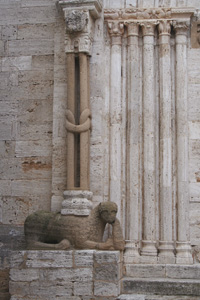 Collegiata dei Santi Quirico e Giulitta, portal Collegiata dei Santi Quirico e Giulitta, portal
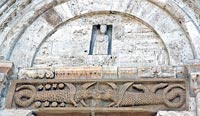 The lintel reliefs of the west portal The lintel reliefs of the west portal
include a couple of mermaids facing off
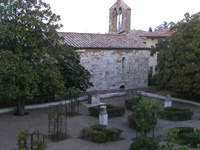
The Horti Leonini garden ends at the Giardino delle Rose, a rose garden outside the church of Santa Maria Assunta.
|
| |
|
|
|
|

Galleria fotografica San Quirico d'Orcia
|
|
|
 |
|
 |
|
 |
Giardino delle Rose, Horti Leonini, San Quirico d'Orcia
|
|
San Quirico d'Orcia
|
|
Chiesa San Francesco, San Quirico d'Orcia |
| |
|
|
|
|
|
|
|
| |
|
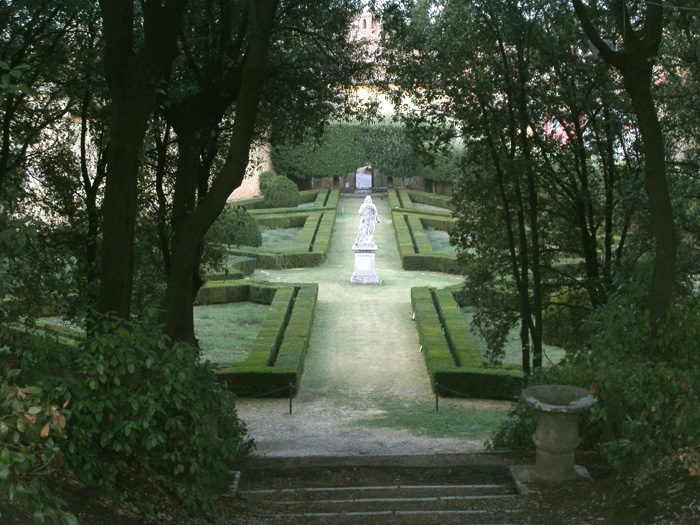
|
Horti Leonini in San Quirico d'Orcia, with its centre a statue of Cosimo III dei Medici, sculpted by Bartolomeo Mazzuoli (1688)
|
Horti Leonini in San Quirico d'Orcia
|
The Horti Leonini gardens are a splendid example of giardini all'italiana: they were designed in about 1540 by Diomede Leoni and periodically host temporary exhibits of contemporary sculpture.
|
The Leonini gardens, or horti, which occupy a large public area in the ancient ramparts of San Quirico d'Orcia, were laid out around 1581 on a piece of land which Francesco I dei Medici donated to Diomede Leoni, hence the name. The gardens retain their original structure to this day, providing a well-preserved example of the traditional Italian-style garden and a method of laying out parks repeated in later centuries.
The lie of the land influenced the layout of the garden, which divides into two areas: the artificial lower section and the more natural upper part. The diamond-shaped lower section, entered through a small brick-built courtyard, is surrounded by walls and pruned ilex. It consists of triangular flower-beds lined with double box hedges, and has at its centre a statue of Cosimo III dei Medici, sculpted by Bartolomeo Mazzuoli (1688). The radial arrangement is given extra movement by the different heights to which the box hedges around each bed are cut. The long avenue, which divides the formal garden into two symmetrical parts, leads up to a flight of steps connecting to a grassy area in the middle of a copse of centuries-old holm-oaks, through which various paths wind their way. A medieval tower that once stood here was destroyed during World War II. The path on the side bordering the town, along the side of the bottom garden and the lower part of the wood, leads to a second 16th-century entrance and a small area, in the eastern corner of the walls planted with rose bushes. The sculptures present in the park, which are interesting for their symbolic significance, include two lions' heads (a reference to the owner's surname from which the gardens take their name) on the entranceway, and the two-headed figure of Janus, on the border beween the wild and the formal garden. While the first is a tribute to the power of Diomede Leoni, the two heads of Janus refer to the two distinct parts of the garden between which it is placed. Inscriptions elsewhere in the gardens are a further reminder of the owner and the designer of these gardens. The outbuildings include a Renaissance pavilion against a wall and a rustic lodge in the upper part of the gardens. The Horti Leonini, which since 1975 have been the property of the town of San Quirico d'Orcia, are opened regularly to the public. To preserve the original layout, a series of conservative restoration schemes have been carried out under the direction of the Architecture and Heritage Department of the provinces of Siena and Grosseto.[1]
The Horti Leonini gardens in San Quirico d'Orcia | Opening times: fromdalle 8.00 until 20.00
Another entrance into the gardens can be found right behind the Santa Maria Assunta church, across the Giardino delle Rose.
Gardens in Tuscany
|
|
|
| |
|

|
|
|
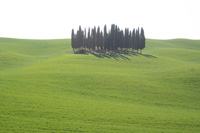 |
|
 |
|
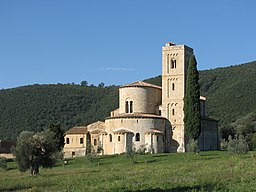 |
| Cipressi tra San Quirico d'Orcia e Montalcino |
|
Acquedotto del Vivo (Acquedotto di Siena) in Monte Amiata Scalo
|
|
Sant'Antimo
|
|
|
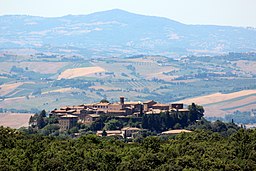 |
|
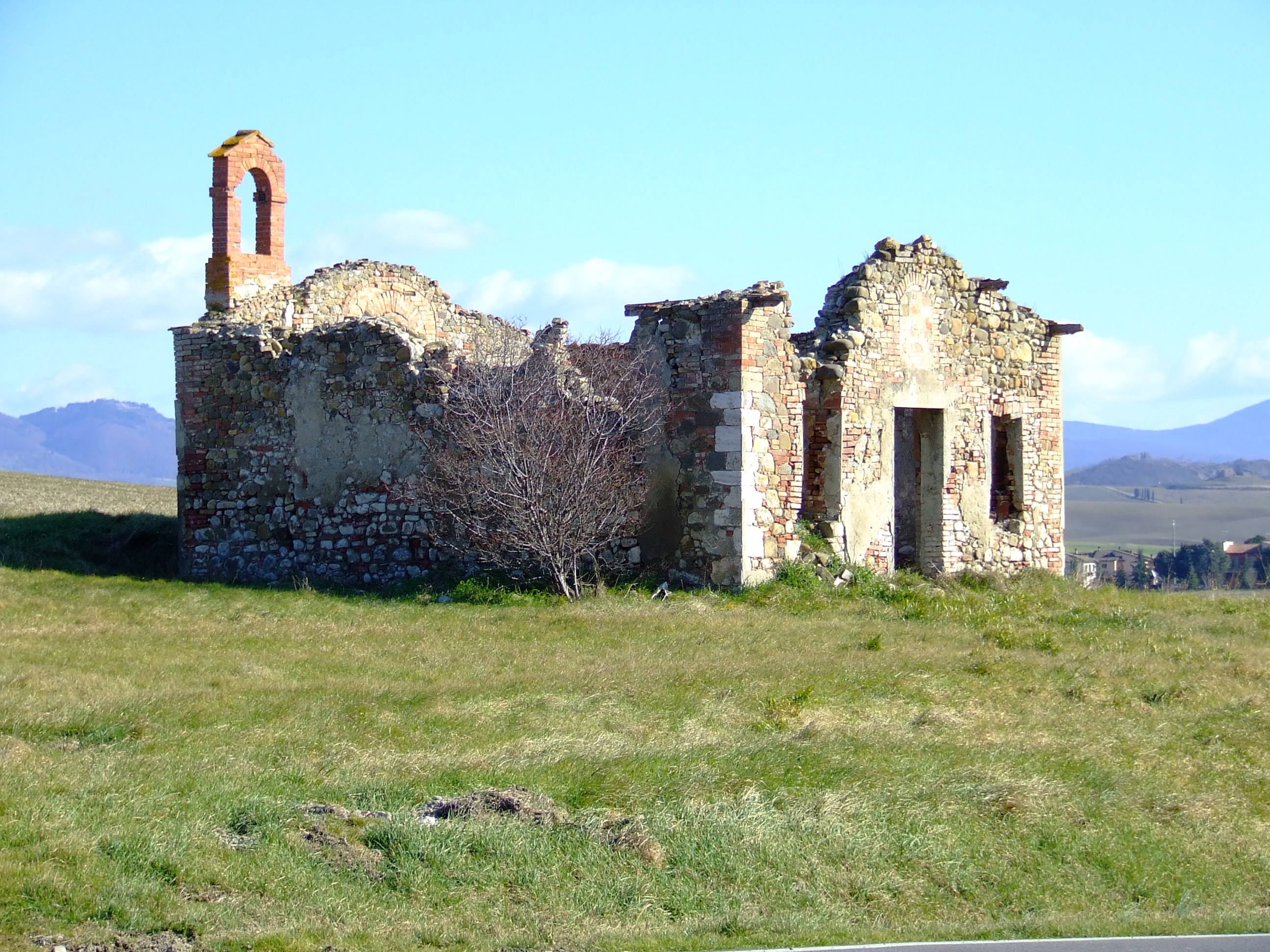
|
Val d'Orcia album
|
|
Sant'Angelo in Colle |
|
Gallina, chiesa di La Scala
|
|
The village of Bagno Vignoni is famous for its main square, almost entirely occupied by the bath built by the Ancient Romans and filled with steaming thermal water. Andrei Tarkovsky shot some scenes of Nostalghia in Bagno Vignoni 1983.
|
|
|
Bagno Vignoni is a small spa of medieval origin, although it was already know in Roman times. Bagno Vignoni sits on a hill above the Val d'Orcia just south of San Quirico. The fascinating tiny village is clustered around a large pool closed on three sides by the town walls, whith water that flows at 52°. The pool essentially fills the square, surrounded by a 1.5 metre-high wall on three sides. All around are buildings designed by Bernardo Rossellino in honour of Pope Pius II, while on the fourth side is the archway from which St. Catherine of Siena admired the view. This place also fascinated Lorenzo il Magnifico of the Medici family, who spent part of 1490 here. The old Francigena road passes near the village, and as the diary written in 1581 by Michel de Montagne confirms, pilgrims and travellers heading toward Rome frequently stopped in Bagno Vignoni to find comfort in its hot springs.
Andrei Tarkovsky shot Nostalghia in Tuscany in 1983. There were two sets he used for his film, Bagno di Vignoni and the Abbadia di San Galgano. Both sets played a very important role in the film, Bagno Vignoni serving as the culmination scene, San Galgano being the backdrop of a marvellous dream sequence staging a small Russican cottage from his childhood in a medieval Tuscan Abbey.
Watch Bagno Vignoni in Tarkovsky's film Nostalghia
Bagno Vignoni's natural hot spring water, is situated a hundred meters downhill on the slope that leads towards the river, at the Parco dei Mulini.
Rocca d'Orcia
|
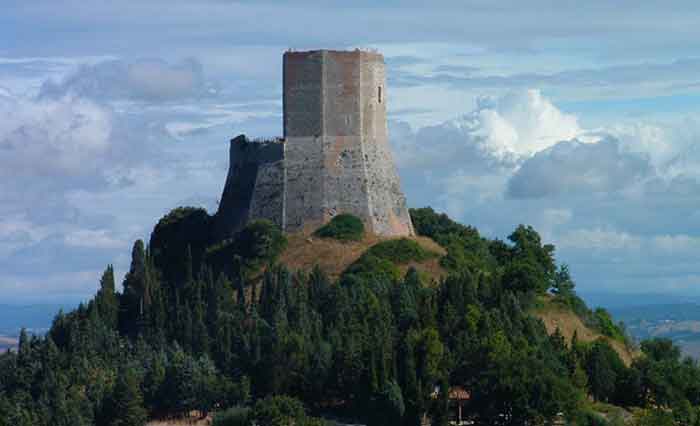 |
Rocca of Tentennano in the tiny borough of Rocca d’Orcia
|
|
Castiglione d'Orcia marks the boundary between Val d'Orcia and the Monte Amiata forests. Once the property of the Aldobrandeschi, family it was fought over in the 14th century between the Salimbeni family and Siena.
The Actual Castiglione, harvest to the feet of the mighty Fortress of the Aldobrandeschis, offers still its medieval aspect to the visitor with picturesque and characteristic angles.
The centre of the town, with its stone-paved streets, is picturesque, and the Piazza il Vecchietta is particularly interesting. This square is dedicated to Lorenzo di Pietro (1412-1480), called II Vecchieta, who was a painter, sculptor and architect. At the centre of the square, completely sloping, there is a fine fountain in travertine dated 1618. In front of the fountain is the Municipal Palace, containing a fresco by the Sienese school (a Virgin Mary with Infant Jesus and two Saints) coming from Rocca d'Orcia.
Castiglione d'Orcia is dominated by the imposing ruins of the Rocca degli Aldobrandeschi. Worth to be visited is the Rocca of Tentennano in the tiny borough of Rocca d’Orcia, which is one of the most famous fortification in the area. Although larger, the village of Castiglione d'Orcia is somewhat less visited than Rocca d'Orcia, its sister village. The reason is that the once dominant fortressof Castiglione d'Orcia lies in ruins, while the Rocca di Tentennano of Rocca d'Orcia has been well-preserved.
Main sights in Castiglione d'Orcia are the Romanesque churches of Santa Maddalena and Santi Stefano and Degna. The latter houses a Virgin Mary with Infant Jesus by Simone Martini and a Madonna with Child by Pietro Lorenzetti.
Weekly market in Castiglione d'Orcia is on the 4th Saturday of the month.
The tiny village of Rocca d'Orcia is crowned by the imposing structure of the Rocca di Tentennano, a fortress that should be visited. Dominating the countryside, this imposing limestone fortification was meant, like so many other structures in the area, so stand guard over the Via Francigena, the pilgrim's road leading from France to Rome.
The Rocca is also famous for more than its military history. According to legend, it was here, in 1377, that Saint Catherine of Siena sought refuge, and experienced a miracle; she was miraculously taught to read and write here in Rocca d'Orcia.
The fortress Rocca di Tentennano owes its name to Tignoso di Tintinnano, a local lord who had it built. All that remains of the original fortress is the huge tower. Although badly damaged by the passage of time, it was restored and the missing sections were replaced by brick. A huge pentagonal courtyard surrounded by ramparts can be seen inside the fortress, which provides splendid views over the surrounding Orcia Valley.
The Rocca di Tentennano was abandoned in the early 20th Century, when it was no longer of any military importance. The last owners, the Scotto family, donated it to the State of Italy, and it is now restored and open to the public.
Sala d'Arte San Giovanni, (Via San Giovanni 10), housed in the former residence of the religious brotherhood of the same name, holds paintings made for Castiglione and Rocca d’Orcia by some of the major representatives of the Sienese school of the XIV and XV centuries: Simone Martini, Lorenzo di Pietro known as Il Vecchietta and Giovanni di Paolo.
Weekly market in Vivo d'Orcia is on the 2nd Saturday of the month.
Contignano is a small village in the centre of the Val d’Orcia, with only five hundred inhabitants, famous for its wonderful pecorino cheese and the festival la Sagra del Raviolo (Ravioli Festival) which happens every year in August.
The Mostra del Geranio (Exhibition of the Geranium) which takes place in April, numerous open air musical concerts which occur in the evocative setting of the historical village centre throughout the summer.
|
Villa La Foce
|
|
|
The property of La Foce lies on the hills overlooking the Val d'Orcia, a beautiful and miraculously intact valley in Southern Tuscany.
La Foce is a re-created renaissance style garden designed by Cecil Pinsent between 1927 and 1939 for Iris Origo, a writer and horticulturalist. After moving to the area in 1924, the Origos dedicated their lives to the development and progress of the Val d'Orcia and its people.
|
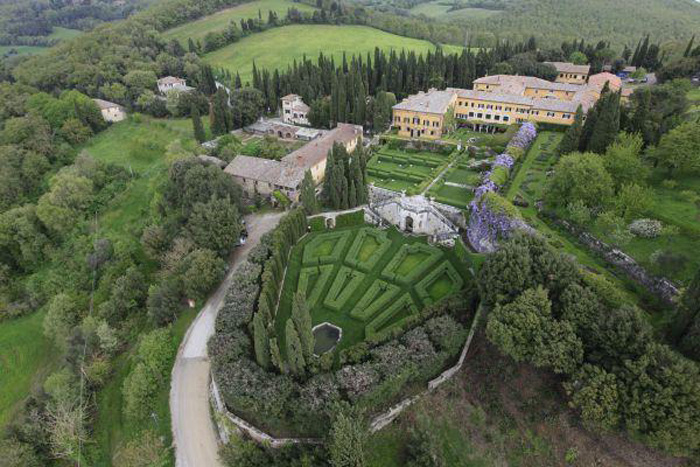 |
| |
|
Villa La Foce estate
|
Villa La Foce, which was originally an inn, was bought by the Origo family in 1927. Marchioness Iris Origo commissioned the well-known landscape gardener Cecil Pinsent to design the garden, to give the home the feel of a Partician residence.
The garden, which divides into three distinct sections on different levels, was created between 1927 and 1939 in several stages, without any loss of compositional unity. The part adjoining the villa spreads over two levels: the lower part, which is the simpler of the two, is enclosed by laurel bushes and decorated with lemon-tree pedestals; the upper section has double box-hedge flower-beds with a travertine fountain in the middle representing two fish holding up the basin on their tails. On the two sides next to the building is a wisteria-draped pergola held up on stone columns, and on the side diametrically opposite to it is a grotto formed from laurel trees and holm-oaks. This first sector leads, through a narrow passageway between pillars topped by two vases similar to those found along the bounday wall, to the lemon garden (a construction begun in 1933). This part of the garden, designed to follow the lie of the land, takes the form of a series of terraces towards the hill, completely altering the traditional pattern of stepped terraces symmetrically arranged around a central axis. The flower-beds, edged with box hedges shaped into hemispheres at the corners and embellished with potted lemon trees, follow the contours of the terrain.
The one architectural feature, apart from the small pergola against the wall of the narrow rose garden, is the flight of steps leading to the wisteria walk and continues up to an avenue lined with cypress trees that ends at the wood.
The rose garden, laid out as a series of geometrically shaped flowerbeds, is bordered on one side by lavender and on the other by various perennial species. The last part of the garden, created in 1938, is connected to the lemon garden by an attractive travertine flight of steps. Underneath these steps, which are adorned with vases, obelisks and a pillared balustrade, is a space known as the "blue grotto", with seven niches inside. This formal garden, enclosed by a wall of cypresses, consists of flower-beds edged in box hedges. The beds converge on a pool, behind which is a bench made of Rapolano travertine, embellished with a statue representing Nature carrying the gifts of the earth on its shoulder.
At the end of the wood is a small cemetery, in which there is small travertine chapel decorated with a Serlian motif. [2]
Gardens in Tuscany | Villa La Foce
|
|
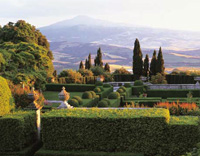
Villa La Foce
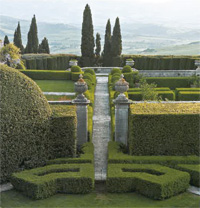
The gardens of La Foce
|

Walking in Tuscany | itineraries for trekking and mountain bike in southern Tuscany
|
|
La Via Francigena | Da San Quirico d'Orcia a Radicofani - 32,7 km
The Via Francigena followed the ancient Roman roads and so pilgrims walked along the route of the current Via Cassia.
The name “Via Francigena”, derives from the word “Francia”, which in Italian designates the French territories, that Via Francigena crosses. The route starts in Canterbury and arrives in Rome, according to records left by Bishop Sigeric, in the year 980.
The Tuscan section of the Via Francigena covers 354 kilometres and 14 legs that touch towns and villages immersed in the most beautiful Tuscan landscapes from Pontremoli in the north to Radicofani in the south of Tuscany.
The first attraction of the day is Vignoni Alto, a village untouched by time that precedes Bagno Vignoni, including an extraordinary thermal pool in the square. The visit to the city centre of Castiglione is worthwhile.
The beautiful descent towards the valley leads us to Le Briccole, which still retains the church of San Pellegrino, and an ancient hospital, now abandoned, but where stayed Francis of Assisi.
|
|
|
From San Quirico d'Orcia (the meeting of the Orcia and Asso waterways) to Bagno Vignoni [details]
|
|
|
Riserva Naturale Lucciola Bella
Riserva Naturale Lucciola Bella is situated southeast of Pienza and Montichiello, in the Val d’Orcia.
The Reserve includes a small corner of the famous landscape of Crete Senesi, which have here their last eastern branches. The river Orcia, springing at a few kilometers in the east, on Monte Cetona, runs at the foot of the protected area by forming a large pebble bed. The main element of the Nature Reserve is without a doubt the landscape characterized by the gullies and above all by the so-called biancane, typical erosive features of the Crete Senesi landscape.
Map
|
|
|
Villa La Foce | Anello La Foce di Chianciano – Riserva di Lucciola Bella – Palazzone – Castelluccio
|
|
|
| |
|
|
| Trekking in Toscana | Anello La Foce di Chianciano – Riserva di Lucciola Bella – Palazzone – Castelluccio |
|
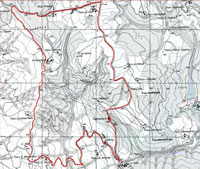 |
Anello La Foce - Vetriana - Monte Cetona
|
|
|
| Trekking in Toscana | Anello La Foce - Vetriana - Monte Cetona |
|
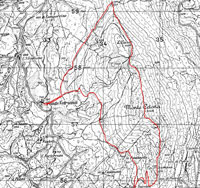 |
| San Quirico d'Orcia | The Festival of Barbarossa
San Quirico d'Orcia celebrates the Festival of Barbarossa on the third Sunday of June. The festival celebrates the visit and brief residence of Federico the First, known as Barbarossa (the Red Beard) to San Quirico in 1155. Barbarossa came to San Quirico for a meeting with the ambassadors of Pope Hadrian IV. He hoped to gain from them the Pope's approval for his coronation of Emperor. The meeting between Barbarossa and the Papal ambassadors was interrupted by Arnaldo of Brescia, a monk accused of heresy for questioning the authority of Pope Hadrian. Barbarossa offered the head of Arnaldo to the ambassadors in exchange for the Pope's blessing and approval of his ambitions.
Members of each of San Quirico's quartiere dress in exquisitely constructed mediaeval costumes to commemorate this historic meeting. The Festa continues throughout the entire day, after beginning in the central piazza where a costumed Consul reads a proclamation announcing Barbarossa's meeting, and then reads the results of a drawing which establishes the order of the participants in the long bow and flag tossing competitions. The four contrade of San Quirico then celebrate with a flag waving and tossing demonstration.
At 4 PM, the meeting between Barbarossa and the Papal ambassadors is recreated in the sandstone courtyard of the Collegiata Church. This is followed by a procession of page boys, ladies and lords, cavaliers on horseback and local gentry dressed in costumes. The procession then finds its way to the upper part of the Horti Leonini for the long bow and flag tossing competitions.

Villa La Foce Estate | La Foce - 61, Strada della Vittoria -53042 Chianciano Terme - Siena | www.lafoce.com
Tuscany | The Val d'Orcia
|

[1] Source: www.cultura.toscana.it
[2] From: ' Giardini in Toscana - Gardens in Tuscany | Un viaggio attraverso la storia dei giardini • A journey through the history of gardens | www.regione.toscana.it | pp. 105-107
|
|
| |

Hidden secrets in Tuscany | Holiday house Podere Santa Pia
|
|
|
|
|
Podere Santa Pia |
|
Podere Santa Pia |
|
|
|
|
|
|
 |
Pienza |
|
Villa Gamberaia |
|
Cipressi tra San Quirico d'Orcia e Montalcino |
| |
|
|
|
|
| |
|
|
|
|
|
Tuscany is one of the most popular tourist destinations in the world. Known for its enchanting landscapes, its fantastic and genuine food and beautiful towns as Florence, Pisa, Lucca and Siena. Podere Santa Pia is located in the heart of the green hills of the Valle d'Ombrone, and one can easily reach some of the most beautiful attractions of Tuscany, such as Montalcino, Pienza, Montepulciano and San Quirico d'Orcia, famous for their artistic heritage, wine, olive oil production and gastronomic traditions.
Hidden away from mass-tourism, discover a piece of Italy which remains largely unchanged both nature and lifestyle-wise. The peacefulness of the countryside, the various unique villages and the friendly atmosphere will no doubt pleasantly surprise you.
Nestled on a rural hillside in the province of Siena in central Tuscany, Podere Siena is old farming cloister, located along the historic Via Francigena, the medieval pilgrimage route from Canterbury to Rome. The Via Francigena was first mentioned in the 3rd century and is Europe's oldest route of pilgrimage. After leaving England, it winds for roughly 600 miles through Arras, Rheims and Lausanne before reaching Tuscany and some of Italy's most beautiful landscapes.
Hospitals, abbeys and churches were built for pilgrims to stop along the way, as well as bridges to ease trade between Italy and northern Europe.
Those interested in exploring the Tuscan part of this ancient road should start south of Siena, along the Via Cassia and into the Val d’Arbia towards Isola d’Arbia. Just outside town is the church of Sant’Ilario, which was a popular stopping point for pilgrims on their way to Rome. After about 10 kilometres there is Buonconvento, a small hamlet that was once a strategic outpost of the lands governed by the Republic of Siena.
Of the many lodgings that existed for pilgrims, some still survive today as agriturismi, or farmhouse residences. Towards Montalcino, the Abbey of Sant’Antimo is definitely worth a stop, before arriving at the Medieval town of San Quirico d’Orcia. The renowned thermal baths at Bagno Vignoni are not far from here.
After Bagno Vignoni the road continues towards the fortresses of Castiglion d’Orcia (Rocca Aldobrandesca) and Rocca d’Orcia, with its magnificent Rocca a Tentennano. Still further south stands Monte Amiata, with its chestnut forests. The most important town on Monte Amiata is Abbadia San Salvatore, where there is also the Abbey of San Salvatore. The Via Francigena leaves the region of Tuscany here and continues towards Rome, often including sections of the Via Cassia.
Another itinerary along the Via Francigena runs through Val d’Elsa, an area of Tuscany that is particularly rich in castles and ancient churches. Starting at Siena, take the Via Cassia towards Monteriggioni into the Pian del Lago, where there is the imposing Castello della Chiocciola castle.
|
 |
|
The island of Montecristo and Corsica, view from Podere Santa Pia in November
|
|
|







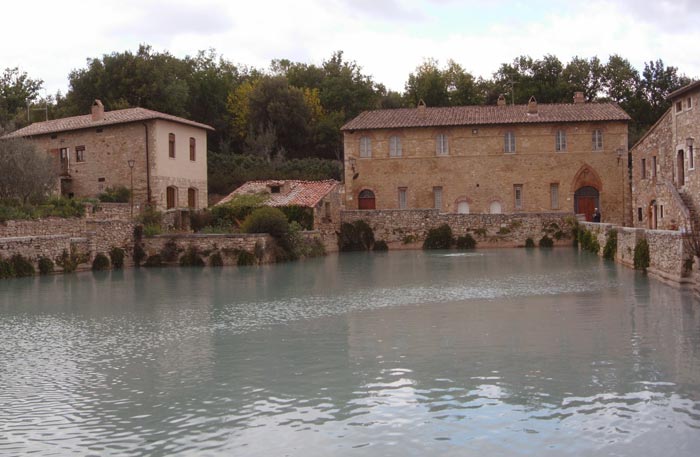






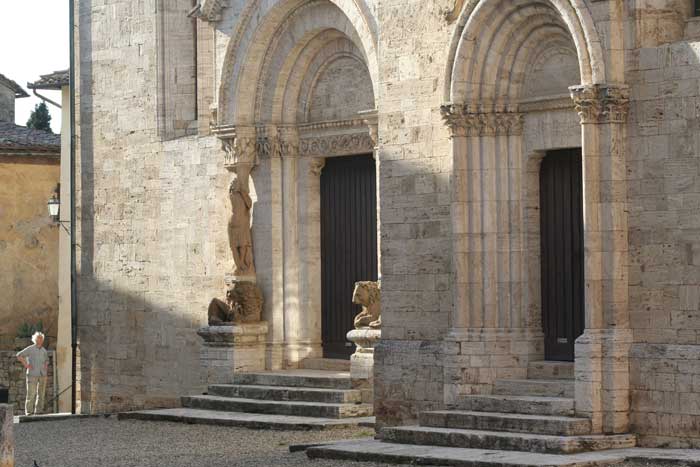
 Collegiata dei Santi Quirico e Giulitta,
Collegiata dei Santi Quirico e Giulitta,









